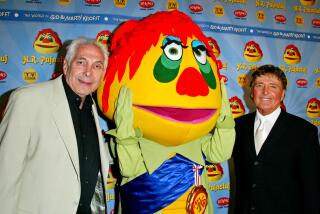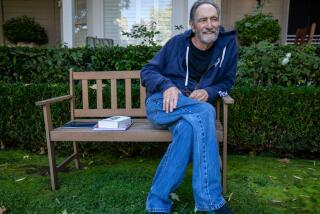Ed ‘Big Daddy’ Roth; Car Designer, Cultural Icon Created Rat Fink
- Share via
Ed “Big Daddy” Roth, the sign painter turned car designer whose outrageous automotive creations and grungy cartoon alter ego, Rat Fink, made him an outlaw icon of Southern California pop culture of the 1950s and ‘60s, has died. He was 69.
Roth’s wife, Ilene, found him dead Wednesday in his workshop near their home in Manti, Utah, said his business associate and friend, David Chodosh. The cause of death had not been determined, Chodosh said Thursday, but he said Roth had been in good health.
In fact, Roth had been at work Wednesday morning on the latest in a long line of custom vehicles. He had first gained fame with the Beatnik Bandit in 1958 and a fiberglass hot rod called the Outlaw in 1959.
His influence on the culture of Southern California was huge, said Ellen Fleurov, museum director at the California Center for the Arts in Escondido, where Roth’s works are on display in “Customized: Art Inspired by Hot Rods, Lowriders and American Car Culture.”
“He really is the Big Daddy,” Fleurov said. “He and Von Dutch and Robert Williams represent the trio of legendary figures who really shaped the aesthetics of hot rod culture and the art that came from it.”
One of Roth’s cars was featured in the recent exhibition “Made in California: Art, Image and Identity, 1900-2000” at the Los Angeles County Museum of Art.
“Our specific purpose,” said Howard Fox, the museum’s curator of modern and contemporary art, “was to reveal the influence of the automobile generally, and the concepts of speed, the aesthetics of sleekness and the interest that painters and sculptors of the 1960s had in new materials we often associate with these fast-paced racing cars, and with “Big Daddy” Roth in particular.
“You can clearly see that influence on the arts, and it certainly had a bigger influence here in the West than it did in the East, where New York largely dominated the art world.”
Nora Donnelly, who organized the “Customized” exhibition for the Institute of Contemporary Art in Boston, where it premiered last fall, said: “An enormous amount of people have been influenced by him, in the hot rod art world as well as in the contemporary art world.”
“His stuff was all outrageous,” said Dick Messer at the Petersen Automotive Museum in Los Angeles, where the Outlaw car now resides. “He was creative, but outrageous.”
Roth developed Rat Fink in the ‘50s as the underground culture’s response to Mickey Mouse. Rat Fink’s sinister glare, razor-sharp teeth and bulging, bloodshot eyes became ubiquitous on T-shirts, posters and car decals in the ‘60s. The character’s wise-guy, street smart attitude lives on in such descendants as Bart Simpson, Ren & Stimpy and the foulmouthed “South Park” kids.
The Revell company sold millions of Big Daddy Roth model car kits, from which Roth received a royalty of 1 cent each.
It was a Revell publicity man who came up with Roth’s nickname after telling him, “We can’t put ‘Beatnik Bandit by Ed Roth’ on the box.”
Roth, who was 6 feet 4, mentioned that he had been called “Big Ed” in high school, so the publicist suggested “Big Daddy,” which Roth loved. Revell, however, lost its love for Roth when he began hanging out with members of the Hells Angels as his interest in customizing motorcycles grew. The company canceled his contract in 1967.
“I know what I am,” Roth told The Times in 1973. “I’m a weirdo. I never grew up.”
His fans admired the energy and anti-establishment attitude he carried throughout his life. In the last two decades, as art museums and other institutions have begun taking a closer look at pop culture, Roth and his peers gained more respect from the academics who had long dismissed their works as lowbrow.
“He was a very singular figure and probably one of the best-known American artists in the country,” Robert Williams, who worked as Roth’s art director from 1965 to 1970, said Thursday.
“But he got absolutely no academic recognition. He took what he inherited from Von Dutch and, between them, they created an American art form.”
Roth was born March 4, 1932, in Beverly Hills to German Lutheran parents. His life was intertwined with cars and pop culture from the beginning: His father worked as a limousine driver for silent film star Mary Pickford.
In elementary school, Roth entertained himself by drawing pictures of airplanes, hot rods and monsters, which were to figure prominently in his most famous creations.
He bought his first car, a 1933 Ford coupe, when he was 14. He earned an engineering degree from what is now East Los Angeles College because he wanted to learn more about automotive design, but later described his college years as a waste of time. He also served in the Air Force.
In the late 1940s, he became fascinated by a new compound called fiberglass when he saw a Ford ad showing how a car made of the material would deflect a sledgehammer blow.
He used fiberglass extensively in creating exotic cars that were extraordinary to behold but mostly impractical to operate.
“The Outlaw runs,” said the Petersen museum’s Messer, “but you won’t be driving it very far unless you’re about 3 feet tall.”
The Outlaw became an immediate hit at car shows when Roth introduced it in 1959. After Revell started producing the model kits, Roth was able to open a studio in Maywood.
It became “sort of a subcultural Grand Central Station for the time,” recalled Williams. Actors, writers, bikers, would-be artists and all manner of humanity stopped by at all hours, said Williams. One writer who was attracted to Roth’s world was Tom Wolfe, who wrote about the scene in his book “The Kandy-Kolored Tangerine-Flake Streamline Baby.”
But while Rat Fink T-shirts and other merchandise and Big Daddy Roth model kits were spreading his name and works into the mainstream, Roth preferred life on the fringes.
He invested all his money in launching a magazine, Choppers, devoted to outlaw motorcycle culture. Increasingly respectable hot rod magazines refused to carry advertising for Choppers, however, and it was a failure. By 1970, Roth was forced to sell his collection of custom cars, 15 vehicles for which he received a total of $5,500.
The Choppers venture also cost him his wife, who divorced him. He decided it was time to reexamine his life, and he turned to the Book of Mormon after a friend gave him a copy.
“I started looking deeper, thinking of things I had done,” he told The Times in 1981. “I guess everybody does that around 39 or 40.” He remarried, to a Mormon woman with two daughters, and converted to that faith and became an elder in the church.
He remained in Southern California, but stayed away from the car culture that had long fascinated him. For much of the 1970s and into the 1980s, he worked as a graphic designer for Knott’s Berry Farm, where he designed menus and painted billboards.
He continued to attend car shows periodically, as one of the few superstars of the hot rod world.
But he remained primarily devoted to his fourth wife, Ilene, and her four children.
No funeral or memorial services have been arranged, but the second annual Rat Fink Party is expected to go on as scheduled on July 21 in Woodland Hills, said organizer and Roth associate Jeffrey Hillinger, also known as Moldy Marvin.
In addition to Ilene, Roth is survived by four stepchildren from Ilene’s previous marriage and five sons from his first marriage.
More to Read
The biggest entertainment stories
Get our big stories about Hollywood, film, television, music, arts, culture and more right in your inbox as soon as they publish.
You may occasionally receive promotional content from the Los Angeles Times.










